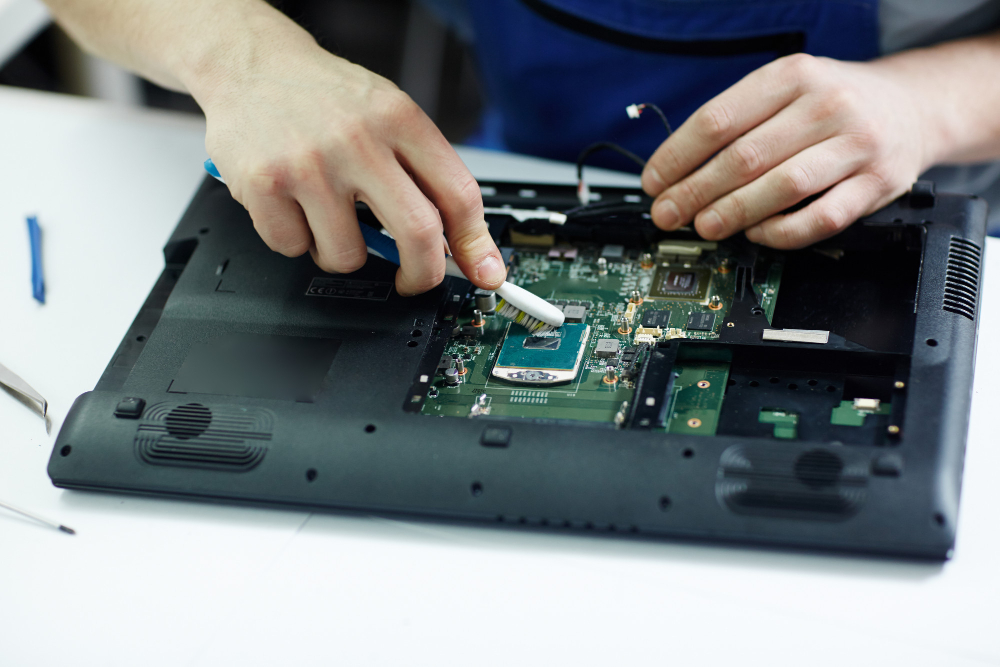This Fix-It Guide on television repair tells how a flat-screen or tube-type television works, what often goes wrong, how to identify a television problem, and what parts and tools you will need to fix it. It then gives simple step-by-step instructions for how to service a mechanical tuner and refers you to instructions for how to test and replace electronic components. Before calling the TV repair service, there are many things you can do yourself to eliminate or reduce the cost of technical repair. The tips in this Fix-It Guide apply to both flat-screen television repair and tube-type television repair. This guide also refers to other Fix-It Guides for dealing with common problems such as electrical cord repair, electrical receptacle repair, remote control repair, and others.
How Does a Television Work?
A television receiver is an electronic device that receives audio and video signals from an antenna, cable/satellite, or a video player and converts those signals into visible light rays and audible sound. A television receiver displays a picture as horizontal lines on the screen. Each line contains a series of red, green, and blue stripes. At viewing distance, the lines and stripes merge and we see a sharp picture in full color. Modern televisions rely on solid-state electronic components that require servicing by a trained technician.
Caution!
Don’t even mess with trying to fix a flat-screen TV. Leave service to a professional. Meantime, review the owner’s manual to determine the probable cause and solution. It may just be an adjustment that you can make.
What Can Go Wrong with a Television?
Most problems that you can fix are caused by loose connections or improperly set controls. TVs made since about 1990 are often adjusted with a hand-held remote and on-screen commands. Finer adjustments can be made by a television service technician. Problems that appear suddenly indicate a failed component, especially if the set has recently been subjected to shock, vibration, or excessive heat. The picture and sound quality gradually deteriorate due to aging.
How Can I Identify a Television Problem?
There are many things you can do before calling for service. First, switch to a different channel or wait a few hours to see if the trouble might be with the cable/satellite service or the broadcaster. Get out your owner’s manual and make sure the controls are set properly. Make sure power is on to the electrical receptacle and test the electrical cord. In addition, check the remote control.
Most TVs have adjustments for brightness, color, and sound. Refer to the owner’s manual for adjustment instructions.
- If there are color blotches in the image, they are usually caused by magnetization of the TVs metal parts or picture tube. Most sets have a built-in device for demagnetizing. Turn the set on for one to two minutes, then turn it off. Repeat several times at half-hour intervals. If this fails, demagnetize the picture tube by running a degaussing coil (available with instructions at electronics parts stores) across the tube with the set turned off.
- If bright areas of a picture look silvery and details are indistinct, the picture tube is defective. When brightness is turned to low level, the picture will appear normal but dull. With brightness up, detail in white areas is lost. The picture may improve after the set has been on for an hour or more, but you’ll eventually have to replace the tube.
Fix-It Tip
How long should your television set last? TVs have an average life of three to eight years of moderate to heavy (eight or more hours per day) use. Most TVs typically last about five years. But many sets are still out there operating at 15+ years. Before investing in costly repairs, check the price of a replacement set. Television sound and picture have improved greatly and there are some good deals available.
What Do I Need for Television Repair?
Replacement parts are available from the manufacturer, aftermarket suppliers, and local electronic stores. The tools you will need to fix a TV include:
- Screwdrivers
- Wrenches
- Tuner or electronic cleaner
What Are the Steps to Television Repair?
Refer to the Fuse Fix-It Guide and the Appliance Controls Fix-It Guide for information on testing and replacing electronic components.
Service a mechanical television tuner (solid-state tuners must be professionally serviced):
- Remove the metal plate protecting the tuner, typically attached to the front of the cabinet.
- To clean the contacts, carefully spray them with a tuner or electronic cleaner, turning the channel selector to distribute the cleaner over the contacts.
- If replacement is required, you may need to de-solder the unit to remove it (see the Fix Anything Fix-It Guide).
Fix-It Tip
Old TVs have vacuum tubes instead of solid-state components. You can purchase them through specialized parts suppliers and larger electronic stores.

